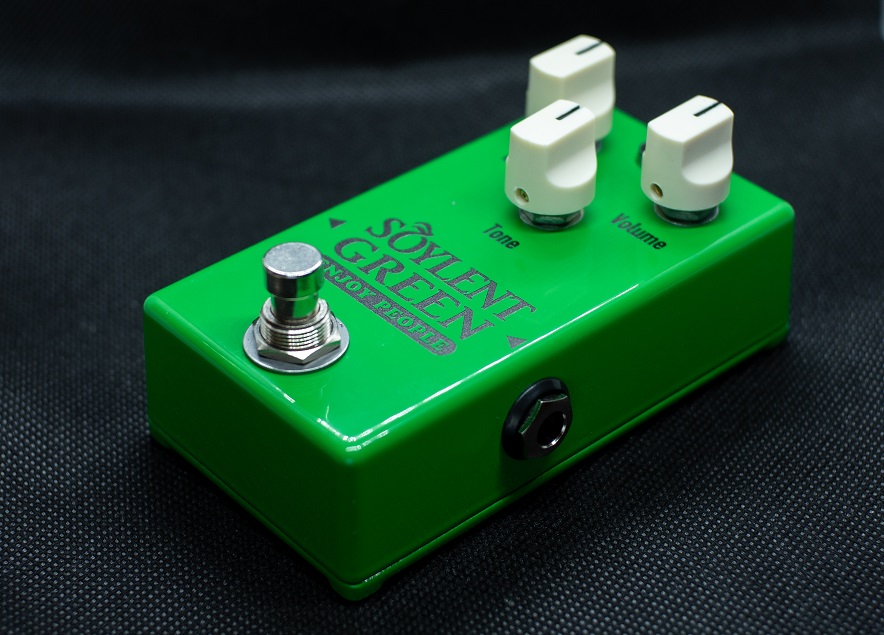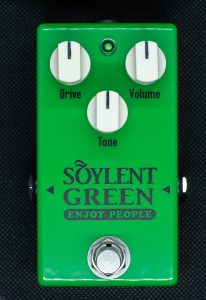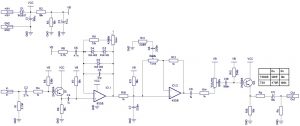
Soylent Green
 So, the day has come… I have avoided The Green Pedal so far, because everybody knows it, the internet is full of articles, reviews and analysis of it. Everyone who is into building pedals have or will build one (or even more) and all the “boutiqe” builders and Chinese copy factories have either their own version or a simple clone of it. A good while ago, at the beginnig of my pedal building career I have built one too. And then disassembled it right away, because I didn’t like its sound too much. Lately I’m looking for boosters and so I have come to the idea to use this one as a booster with the Drive pot all the way down and the Volume pot cranked. Lo and behold: exactly what I wanted! It does not increase the volume level too much, but boosts exactly the frequencies that make your guitar shine out of the mix. As an OD on its own I still don’t like it because its low gain and it can’t really be boosted either because of the narrow frequency range it works in. But as a booster it has found its place on my board, it can push any OD or distortion pedal or even the frontend of an amp very nicely. Of course we are talking about the Ibanez Tube Screamer.
So, the day has come… I have avoided The Green Pedal so far, because everybody knows it, the internet is full of articles, reviews and analysis of it. Everyone who is into building pedals have or will build one (or even more) and all the “boutiqe” builders and Chinese copy factories have either their own version or a simple clone of it. A good while ago, at the beginnig of my pedal building career I have built one too. And then disassembled it right away, because I didn’t like its sound too much. Lately I’m looking for boosters and so I have come to the idea to use this one as a booster with the Drive pot all the way down and the Volume pot cranked. Lo and behold: exactly what I wanted! It does not increase the volume level too much, but boosts exactly the frequencies that make your guitar shine out of the mix. As an OD on its own I still don’t like it because its low gain and it can’t really be boosted either because of the narrow frequency range it works in. But as a booster it has found its place on my board, it can push any OD or distortion pedal or even the frontend of an amp very nicely. Of course we are talking about the Ibanez Tube Screamer.
 The analysis of the circuit can be found all over the net, I would like to mention two, that are the best IMO: R. G. Keen “The Technology of the Tube Screamer” and ElectroSmash “Tube Screamer Analysis”. I can’t add too much more, I would like to mention a few modding options though:
The analysis of the circuit can be found all over the net, I would like to mention two, that are the best IMO: R. G. Keen “The Technology of the Tube Screamer” and ElectroSmash “Tube Screamer Analysis”. I can’t add too much more, I would like to mention a few modding options though:
1) The frequency response can be changed with changing R8 and C6. These lower the gain for the frequencies below about 720Hz. With tuning this filter lower the bass response can be extended.
2) The frequency response can be extended with changing the R10 and C7 low-pass filter too. This filters out frequencies above about 720Hz (again…) after the amplifier stage.
3) If you want more distortion you can increase the Drive pot to 1M and/or lower the R8 value. If you decide for the latter though, then you have to keep in mind that your filter will change. To keep it at the same frequency response as the original you need to increase C6 at the same time so that the R8*C6 product remains the same.
4) I have followed the Madbean Green Bean schematic with the clipping diode section and used an asymmetric Si diode arrangement. If you want the original’s symmetric layout simply replace D4 with a jumper. Or – as with any clipping diode circuits – you can freely experiment, however you have to keep in mind that the effect has a pretty low overall volume and a lower forward voltage diode arrangement (such as Ge or Schottky diodes) will decrease this further. You may end up with a circuit that has lower overall volume as the uneffected sound.
5) With the correct values of Ra and Rb you can build both the TS808 and the TS9 variants. In the case of the TS808 version the overall volume of the effect is so low that it is unsuitable for boosting; with the Drive all the way down and the Volume all the way up its overall volume is still lower than the clean signal. In my pedal I have used a jumper for Ra and 100k for Rb.
You can find the build docu under the Projects menu.


No Comments